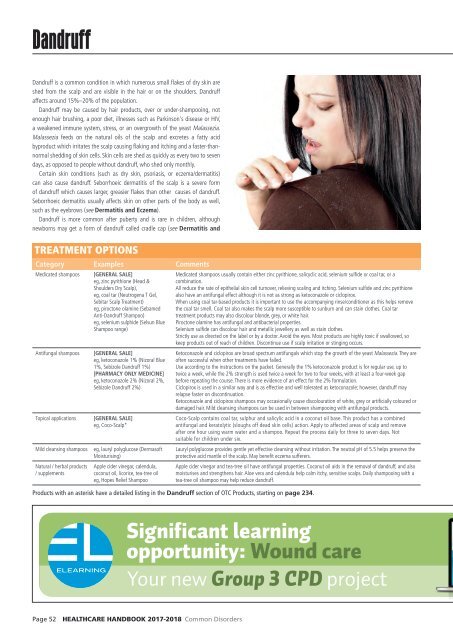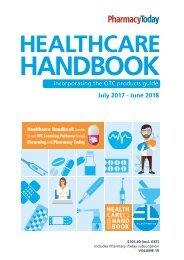2017 HCHB_digital
Create successful ePaper yourself
Turn your PDF publications into a flip-book with our unique Google optimized e-Paper software.
Dandruff<br />
Dandruff is a common condition in which numerous small flakes of dry skin are<br />
shed from the scalp and are visible in the hair or on the shoulders. Dandruff<br />
affects around 15%–20% of the population.<br />
Dandruff may be caused by hair products, over or under-shampooing, not<br />
enough hair brushing, a poor diet, illnesses such as Parkinson's disease or HIV,<br />
a weakened immune system, stress, or an overgrowth of the yeast Malassezia.<br />
Malassezia feeds on the natural oils of the scalp and excretes a fatty acid<br />
byproduct which irritates the scalp causing flaking and itching and a faster-thannormal<br />
shedding of skin cells. Skin cells are shed as quickly as every two to seven<br />
days, as opposed to people without dandruff, who shed only monthly.<br />
Certain skin conditions (such as dry skin, psoriasis, or eczema/dermatitis)<br />
can also cause dandruff. Seborrhoeic dermatitis of the scalp is a severe form<br />
of dandruff which causes larger, greasier flakes than other causes of dandruff.<br />
Seborrhoeic dermatitis usually affects skin on other parts of the body as well,<br />
such as the eyebrows (see Dermatitis and Eczema).<br />
Dandruff is more common after puberty and is rare in children, although<br />
newborns may get a form of dandruff called cradle cap (see Dermatitis and<br />
TREATMENT OPTIONS<br />
Category Examples Comments<br />
Medicated shampoos<br />
Antifungal shampoos<br />
Topical applications<br />
Mild cleansing shampoos<br />
Natural / herbal products<br />
/ supplements<br />
[GENERAL SALE]<br />
eg, zinc pyrithione (Head &<br />
Shoulders Dry Scalp),<br />
eg, coal tar (Neutrogena T Gel,<br />
Sebitar Scalp Treatment)<br />
eg, piroctone olamine (Sebamed<br />
Anti-Dandruff Shampoo)<br />
eg, selenium sulphide (Selsun Blue<br />
Shampoo range)<br />
[GENERAL SALE]<br />
eg, ketoconazole 1% (Nizoral Blue<br />
1%, Sebizole Dandruff 1%)<br />
[PHARMACY ONLY MEDICINE]<br />
eg, ketoconazole 2% (Nizoral 2%,<br />
Sebizole Dandruff 2%)<br />
[GENERAL SALE]<br />
eg, Coco-Scalp*<br />
eg, lauryl polyglucose (Dermasoft<br />
Moisturising)<br />
Apple cider vinegar, calendula,<br />
coconut oil, licorice, tea-tree oil<br />
eg, Hopes Relief Shampoo<br />
Medicated shampoos usually contain either zinc pyrithione, salicyclic acid, selenium sulfide or coal tar, or a<br />
combination.<br />
All reduce the rate of epithelial skin cell turnover, relieving scaling and itching. Selenium sulfide and zinc pyrithione<br />
also have an antifungal effect although it is not as strong as ketoconazole or ciclopirox.<br />
When using coal tar-based products it is important to use the accompanying rinse/conditioner as this helps remove<br />
the coal tar smell. Coal tar also makes the scalp more susceptible to sunburn and can stain clothes. Coal tar<br />
treatment products may also discolour blonde, grey, or white hair.<br />
Piroctone olamine has antifungal and antibacterial properties.<br />
Selenium sulfide can discolour hair and metallic jewellery as well as stain clothes.<br />
Strictly use as directed on the label or by a doctor. Avoid the eyes. Most products are highly toxic if swallowed, so<br />
keep products out of reach of children. Discontinue use if scalp irritation or stinging occurs.<br />
Ketoconazole and ciclopirox are broad spectrum antifungals which stop the growth of the yeast Malassezia. They are<br />
often successful when other treatments have failed.<br />
Use according to the instructions on the packet. Generally the 1% ketoconazole product is for regular use, up to<br />
twice a week, while the 2% strength is used twice a week for two to four weeks, with at least a four-week gap<br />
before repeating the course. There is more evidence of an effect for the 2% formulation.<br />
Ciclopirox is used in a similar way and is as effective and well tolerated as ketoconazole; however, dandruff may<br />
relapse faster on discontinuation.<br />
Ketoconazole and ciclopirox shampoos may occasionally cause discolouration of white, grey or artificially coloured or<br />
damaged hair. Mild cleansing shampoos can be used in between shampooing with antifungal products.<br />
Coco-Scalp contains coal tar, sulphur and salicylic acid in a coconut oil base. This product has a combined<br />
antifungal and keratolytic (sloughs off dead skin cells) action. Apply to affected areas of scalp and remove<br />
after one hour using warm water and a shampoo. Repeat the process daily for three to seven days. Not<br />
suitable for children under six.<br />
Lauryl polyglucose provides gentle yet effective cleansing without irritation. The neutral pH of 5.5 helps preserve the<br />
protective acid mantle of the scalp. May benefit eczema sufferers.<br />
Apple cider vinegar and tea-tree oil have antifungal properties. Coconut oil aids in the removal of dandruff, and also<br />
moisturises and strengthens hair. Aloe vera and calendula help calm itchy, sensitive scalps. Daily shampooing with a<br />
tea-tree oil shampoo may help reduce dandruff.<br />
Products with an asterisk have a detailed listing in the Dandruff section of OTC Products, starting on page 234.<br />
Significant learning<br />
opportunity: Wound care<br />
Your new Group 3 CPD project<br />
Page 52 HEALTHCARE HANDBOOK <strong>2017</strong>-2018 Common Disorders



